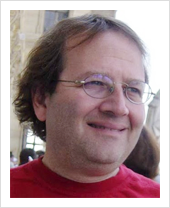It’s one thing to look back on a project with the power of hindsight and recognize that project’s impact. It’s quite another to realize a project will be profound as it’s still playing out.
Andy Hertzfeld had that rare experience when he was working on the original Macintosh. Hertzfeld and his colleagues knew the first Mac could reshape the boundaries of computing, and that knowledge proved to be an important motivator for the team.
Over the years, Hertzfeld has chronicled many of the stories surrounding the Macintosh’s development through his website, Folklore.org, and in his 2004 book, “Revolution in the Valley.” With the book making its paperback debut and the work of Steve Jobs and Apple fresh in people’s minds, I checked in with Hertzfeld to revisit a few of those past stories and discuss the long-term legacy of the Macintosh.
Our interview follows.
What traits did people on the Macintosh team share?
 Andy Hertzfeld: Almost everyone on the early Macintosh team was young, super smart, artistic and idealistic. We all shared a passionate conviction that personal computers would change the world for the better.
Andy Hertzfeld: Almost everyone on the early Macintosh team was young, super smart, artistic and idealistic. We all shared a passionate conviction that personal computers would change the world for the better.
At what point during the Macintosh’s development did you realize this was a special project?
Andy Hertzfeld: We knew it from the very beginning; that’s why we were so excited about it. We knew that we had a chance to unlock the incredible potential of affordable personal computers for the average individual for the very first time. That was incredibly exciting and motivating.
Between the book and your website, did the story of the Macintosh take on a “Rashomon“-like quality for you?
Andy Hertzfeld: I was hoping for more of that than we actually achieved — there haven’t been enough stories by varied authors for that to come to the forefront. The most “Rashomon”-like experience has been in the comment section of the website, where people have corrected some of my mistakes and sometimes described an alternate version that’s different than my recollections.
How did the Macintosh project change after Steve Jobs got involved?
Andy Hertzfeld: It became real. Before Steve, the Macintosh was a small research project that was unlikely to ever ship; after Steve, it was the future of Apple. He infused the team with a fierce urgency to ship as soon as possible, if not sooner.
There’s a story about how after Jobs brought you onto the Macintosh team, he finalized the move by yanking your Apple II’s power chord out of its socket. Was that an unusual exchange, or did Jobs always act with that kind of boldness?
Andy Hertzfeld: Well, not always, but often. Steve was more audacious than anyone else I ever encountered.
In the book, you wrote that as soon as you saw the early Mac logic board you knew you had to work on the project. What about that board caught your attention?
Andy Hertzfeld: It was the tightness and cleverness of the design. It was a clear descendant of the brilliant work that Steve Wozniak did for the Apple II, but taken to the next level.
Was the logic board the gravitational center for the project?
Andy Hertzfeld: I would say that Burrell Smith’s logic board was the seed crystal of brilliance that drew everyone else to the project, but it wasn’t the gravitational center. That would have to be the user interface software. My nomination for the gravitational center is Bill Atkinson’s QuickDraw graphics library.
 Revolution in The Valley: The Insanely Great Story of How the Mac Was Made — “Revolution in the Valley” reveals what it was like to be there at the birth of the personal computer revolution. The story comes to life through the book’s portrait of the talented and often eccentric characters who made up the Macintosh team.
Revolution in The Valley: The Insanely Great Story of How the Mac Was Made — “Revolution in the Valley” reveals what it was like to be there at the birth of the personal computer revolution. The story comes to life through the book’s portrait of the talented and often eccentric characters who made up the Macintosh team.Where does the graphical user interface (GUI) rank among tech milestones? Is it on the same level as the printing press or the Internet?
Andy Hertzfeld: It’s hard to compare innovations from different eras. I think both the printing press and the Internet were more important than the GUI, but the Internet couldn’t have reached critical mass without the GUI enabling ordinary people to enjoy using computers.
In the book’s introduction you wrote that the team “failed” because computers are still difficult. Has computer complexity improved at all?
Andy Hertzfeld: I think things have improved significantly since I wrote that in 2004, mainly because of the iPhone and iPad, which eliminated lots of the complexity plaguing desktop computing. That said, I think we still have a ways to go, but newer developments like Siri are very promising.
What do you think the long-term legacy of the Macintosh will be?
Andy Hertzfeld: The Macintosh was the first affordable computer that ordinary people could tolerate using. I hope we’re remembered for making computing delightful and fun.
Would a current Apple fan have anything in common with a Macintosh-era Apple fan?
Andy Hertzfeld: Sure, a love for elegant design and bold innovation. They both think differently.
This interview was edited and condensed.
Related:
